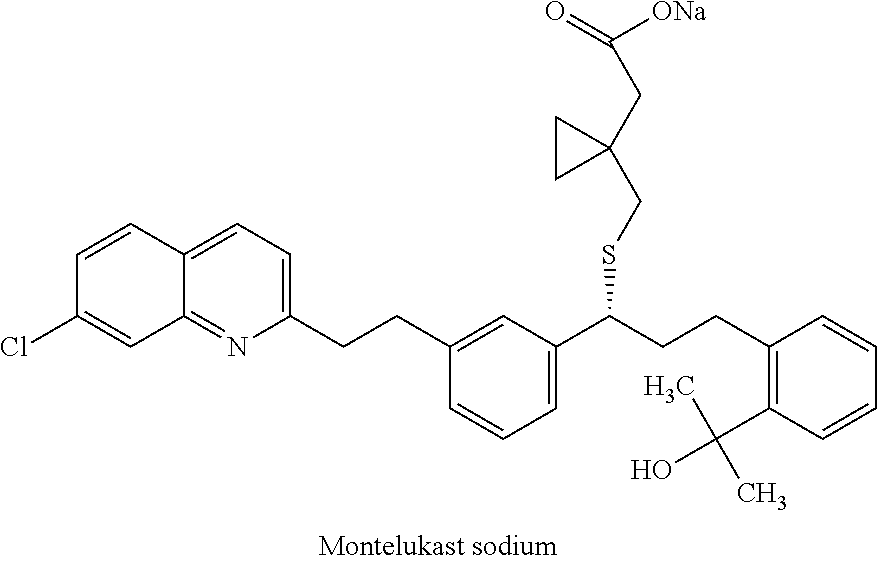Process for preparing montelukast and salts thereof
a technology of montelukast and salt, which is applied in the field of improvement, can solve the problem that the process is not suitable for large-scale production
- Summary
- Abstract
- Description
- Claims
- Application Information
AI Technical Summary
Benefits of technology
Problems solved by technology
Method used
Image
Examples
examples
[0041]The present invention will now be further explained in the following examples. However, the present invention should not be construed as limited thereby. One of ordinary skill in the art will understand how to vary the exemplified preparations to obtain the desired results.
example-i
Preparation of (S)-1-(3-((E)-2-(7-chlorogninolin-2-yl)vinyl)phenyl)-3-(2-(1-hydroxy-1-methylethyl)phenyl]propyl acetate
[0042]To a stirred solution of 2-[2-[3(S)-[3-[2-(7-Chloro-2-quniolinyl)ethenyl]phenyl]-3-hydroxy propyl]phenyl]-2-propanol (100 gm) in dichloromethane (500 ml) at 25-30° C. 4-di(methyl amino)pyridine (5.32 gm) was added and cooled to 0° C. To the reaction mixture Triethylamine (26.4 gm) was added at 0° C. Acetic anhydride (26.7 gm) was added slowly at temp.0-5° C. over 30-60 min and maintained the reaction at temp. 0-5° C. over 30 min. Reaction completion was monitored by TLC. After reaction completion the reaction mass was quenched into 7% NaHCO3(500 ml) and stirred for 15 min. Temperature was raised to 25-30° C. and maintained for 30 min. Reaction mass was settled for 15 min and separated the organic layer. Aq.layer was extracted with dichloromethane (250 ml). The combined organic layer was washed with 25% NH4Cl solution (500 ml). Organic layer was distilled below...
example-ii
Preparation of (S)-1-(3-((E)-2-(7-chloroquinolin-2-yl)vinyl)phenyl)-3-(2-isopropenyl phenyl]propyl acetate
[0044]PTSA (62.4 gm) was suspended in toluene (300 ml) at 25-30° C. and moisture was removed by azeotropic distillation. After removal of moisture reaction mass was cooled to 70° C. and distilled toluene completely under reduced pressure to get residue. The obtained residue was cooled to room temperature and charged dichloromethane (300 ml) and stage-I (108 gm of stage-I dissolved in 200 ml dichloromethane). The reaction mass temp was raised to reflux and maintained for 2 hrs. Reaction completion was monitored by TLC. After reaction completion the reaction mass was quenched into 7% NaHCO3 (300 ml) and stirred for 15 min. Reaction mass temp was raised to 25-30° C. and maintained for 30 min. Reaction mass was settled for 15 min and the organic layer was separated. Aq.layer was extracted with dichloromethane (200 ml) at 25-30° C. The combined organic layer was washed with of DM Wat...
PUM
 Login to View More
Login to View More Abstract
Description
Claims
Application Information
 Login to View More
Login to View More - R&D
- Intellectual Property
- Life Sciences
- Materials
- Tech Scout
- Unparalleled Data Quality
- Higher Quality Content
- 60% Fewer Hallucinations
Browse by: Latest US Patents, China's latest patents, Technical Efficacy Thesaurus, Application Domain, Technology Topic, Popular Technical Reports.
© 2025 PatSnap. All rights reserved.Legal|Privacy policy|Modern Slavery Act Transparency Statement|Sitemap|About US| Contact US: help@patsnap.com



